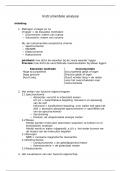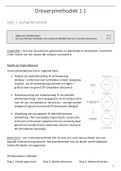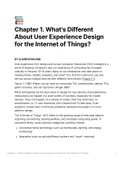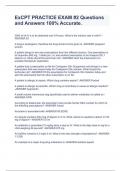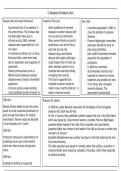Chapter 14: Central Banks
Origins of the Central Banking System
- Initially mostly about lending money to the government, later evolved to safeguard
monetary stability.
- EU: European central banks is a sole central bank policing the other banks.
- United States: More cautious in giving one central bank that much power -> eventually
Federal Reserve System set up in 1913 (system of twelve regional Federal Reserve banks).
Variation in the Functions and Structures of Central Banks
- The ECB: Established in 1998 to handle transitional issues of nations in the Eurozone.
-> Monetary policy transferred from NCBs to the ECB.
- Eurosystem: ECB + all NCBs within in the Eurozone.
- European System of Central Banks (ESCB): ECB + all NCBs of all EU member states.
- Capital stock of ECB owned by 28 EU member states (most by the 19 members in the euro
area).
- Decision-making bodies:
- Governing Council: ECB president and vice-president, four members of Executive Board
and the governors of the NCBs of the Eurozone countries.
-> Formulates monetary policy.
- Executive Board: Appointed by European Council: President, vice-president and four
independent members.
-> Responsible for day-to-day operations and implements decisions of Governing Council
by instructing the NCBs.
- General Council: President, vice-president and governors of NCBs of EU member states.
-> Encourages cooperation between NCBs and performs advisory functions.
- Primary objective: Maintain medium-term inflation close but below 2%.
- Instruments: Policy interest rates (deposit facility rate, refinancing rate and marginal
lending rate), open market operations, standing facilities (overnight liquidity) and minimum
reserve requirements for credit institutions.
- Unconventional instruments: Emergency Liquidity Assistance, QE.
-> To provide liquidity to financial markets.
- Federal Reserve System:
- Complete independence from government, only periodically reviewed by Congress.
- Privately owned by its member banks.
- Twelve regional Federal Reserve banks implement the Fed’s dual mandate of price and
macroeconomic stability (output, unemployment).
- Board of Governors: Regulatory and supervisory responsibility over member banks.
- Open Market Committee: Seven members of Board of Governors, president of regional
Bank of New York and 4 other regional Federal Reserve Bank governors.
-> Decides on monetary policy.
,- ECB and Fed: Both independent, bind regional central banks,
-> ECB primarily price stability, Fed also macroeconomic stability.
-> Board of Governors controls budget regional Federal Reserve banks, whereas in Europe
the NCBs control their own budgets and the ECB budget.
-> Monetary operations in Eurozone conducted by NCBs, in Fed centralized.
-> Fed regulates and supervises financial institutions, in Eurozone this is left to individual
countries.
- Bank of England: Court of Directors all appointed by the queen (at recommendation of the
prime minister.
-> Monetary Policy Committee responsible for monetary policy.
-> Mandate: Price stability and support government’s economic objectives (growth,
unemployment).
Structure of Central Banks in Larger Economies
- The Bank of Canada: Supervises and regulates Canadian banks and reports its monetary
policy decision to government, who has the ultimate responsibility.
-> Though government has never actively adjusted monetary policy.
-> Mandate: Preserve value of money by keeping inflation low, stable and predictable.
- The Bank of Japan: Only since lately independent from the government.
-> Mandate: Price stability and financial stability to achieve stable and sustainable
macroeconomic growth.
-> BoJ determines monetary policy, though exchange rate policy is performed on behalf of
the Ministry of Finance (government).
- The People’s Bank of China: State owned, only minority shares are hold by the public.
-> Mandate: Stability of the value of the currency and to reduce overall risk.
-> Various government institutions represented in Monetary Policy Committee -> strong
government control over PBoC -> one of the least independent central banks around.
Structure and Independence of Central Banks in Emerging Market Economies
- Central banks in fast growing economies have a tough job to continuously develop rapidly
maturing financial markets, implement monetary policy, supervise and regulate banks and
oversee the payment system.
- Foreign exchange policies often implemented in collaboration with the government.
- Financial inclusion policies: Enhancing credit flows to productive fast-growing export-
orientated industries, which leaves the agricultural sector underbanked, so access to
financial services and education should be promoted.
-> These go hand-in-hand with fiscal policies -> independence of central banks weaker.
Should Central Banks Be Independent
- Goal independence: Institutional characteristics that protects the central bank from
political influence in defining its monetary policy objectives.
- Instrument independence: Ability of central banks to freely implement instruments to
pursue their monetary goals.
- For independence:
, - Political business cycle: Politicians that implemented inflationary policies to stimulate
output in the short run just before elections and after elections run reversed policies to limit
inflation: unnecessary macroeconomic instability.
- Politicians lack expertise in conducting monetary policy.
- Politicians might be unwilling to take unpopular macroeconomic decisions, so better to
give central bank more independence to avoid public criticism.
- Against independence:
- Coordination between fiscal and monetary policy not possible.
- Central bank not immune for political pressures; might pursue more power and prestige at
the expense of the public interest.
- Trend: Central banks become more independent due to high correlation between
macroeconomic stability and independence of central banks.
Chapter 15: The Money Supply Process
Three Players in the Money Supply Process
- Central bank (government agency), banks (financial intermediaries) and depositors.
The Fed’s Balance Sheet
- Liabilities: Monetary liabilities (currency in circulation and reserves) form together with the
Treasury’s monetary liabilities the monetary base.
- Currency in circulation: Amount of currency in the hands of the public (deposits are
reserves)
- Reserves: Deposits of banks held at the central bank + currency physically held by banks
(vault cash).
-> If reserves or currency in circulation increases, deposits or currency in hands of public
rises -> money supply increases.
- Assets: Earn higher interest than their liabilities (cost nothing) -> most earnings returned to
government, some spend to worthy causes.
- Securities: Most common way in which a central bank provides reserves to the banking
system is by purchasing securities.
- Loans to financial institutions: Loans that are liabilities to financial institutions, though
increase central banks’ reserves and money supply.
Control of the Monetary Base
- MB = C (currency in circulation) + R (reserves).
-> Controlled through open market operations (purchases of securities in the open market).
-> Performed through primary dealers: dealers that operate via private banking
institutions.
- Open market purchase:
- Banking system: Assets -> securities go down, reserves go up.
- Central bank: Assets -> securities up; Liabilities -> reserves go up.
-> Monetary base goes up by an amount equal to the purchase.
- Open market sale: Exactly the opposite of a purchase.
, - Transfer deposit to currency:
- Nonbank (public): Currency goes up, checkable deposits go down.
- Banking system: Checkable deposits go down, reserves go down.
- Central bank: Currency in circulation goes up, reserves go down.
-> No effect on monetary base, only reserves affected.
- Loan to financial institution:
- Banking system: Reserves (asset) and loans (liability) go up.
- Central bank: Loans (asset) and reserves (liability) go up.
-> Also affected by willingness of banks to borrow at the set discount rate.
- Float: If money is moved from one account to another, first the bank that deposited is
credited, before the other bank is debited -> temporary increase in reserves and thus in MB.
- US Treasury: Could move deposits from commercial banks to the central bank, resulting in
a fall in reserve and thus in MB.
-> Last two effects affect MB without the Fed having any influence.
- Central bank has most control over nonborrowed monetary base (MBn -> open market
operations) and little over borrowed reserves (BR): MB n=MB−BR .
Multiple Deposit Creation: A Simple Model
- Open market purchase at national bank:
- National bank has increase in reserves -> used to give out loans, so loans and checkable
deposits increase.
-> Borrowers will make purchases with the checks, so reserves of national bank falls.
- Other banks receive additional deposits and thus see their checkable deposits and
reserves increase.
-> Increase in checkable deposits requires them to hold more reserves, though there are
still some excess reserves -> used for loans -> will be spend by borrowers and deposited at
another bank -> checkable deposits and reserves go up at the other bank -> excess reserves
used for new loans.
- Deposit expansion: Total increase in deposits from an initial increase in reserves is the
reciprocal of the reserve requirement percentage times the initial increase in reserves.
-> Does not matter whether reserves are used to make loans or to purchase securities.
1
∆ D= ∗∆ R .
rr
- Banking system is in equilibrium if excess reserves are zero -> if RR = R, where RR = rr*D.
-> A certain level of reserves, supports a certain level of checkable deposits.
-> If reserves increase by a certain value, checkable deposits must increase by 1/rr times
the increase in reserves, for required reserves to increase by the same amount as reserves.
- Critique: Model does not take into account the possibility of loans being used to raise
holdings of currency instead of being used to deposit and the possibility of banks to hold on
to excess money.
-> These options cause the full expansion of deposits not to happen.
-> Depositors’ decisions and banks’ decisions regarding excess reserves also determine
money supply.



